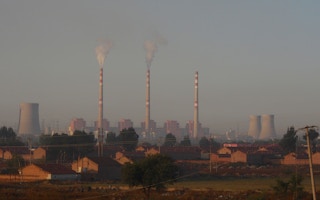China could slash its climate-changing emissions by 30 per cent if all its cities cleaned up pollution from their dirtiest power plants and factories, researchers said on Wednesday.
The world’s biggest emitter of greenhouse gases needs to focus on its urban areas in order to meet national-level targets under the international Paris Agreement to curb global warming, according to scientists at the University of East Anglia (UEA).
“To do this successfully you need to have a good idea of how to cut pollution at a local level without devastating local economies,” said lead researcher Dabo Guan.
A world-first analysis of emissions data from 182 cities across China shows the importance of setting emissions control policies for urban areas, Guan told the Thomson Reuters Foundation.
Improving the efficiency and environmental impact of the top five per cent of polluters in cities could see China’s emissions fall by 30 per cent, according to Guan, a professor of climate change economics at UEA.
The analysis revealed a vast discrepancy in the economic growth and carbon footprint of China’s cities, which range from high-tech urban hubs to coal-dependent manufacturing bases.
To curb pollution, each city requires a “different low-carbon road map”, specifically tailored to its economy, energy industry and carbon dioxide output, Guan said.
Under the Paris Agreement, China pledged to decrease its carbon intensity—the amount of climate-warming carbon dioxide it produces per unit of economic growth—by 60 per cent.
China’s wealthiest cities like Shanghai have significantly cut emissions in the past five years by investing in renewable energy and outsourcing energy-intensive production to other regions.
But manufacturing cities in northern Shanxi province, which rely heavily on coal, saw an annual average increase of more than 1.5 per cent.
Investment in hi-tech equipment, such as energy-efficient boilers, is the most effective way for China’s worst-polluting cities to reduce their emissions, Guan said.
This story was published with permission from Thomson Reuters Foundation, the charitable arm of Thomson Reuters, that covers humanitarian news, climate change, resilience, women’s rights, trafficking and property rights. Visit http://news.trust.org.

















